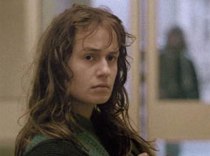 What the mystery boils down to is: who, or what, are we? In Agnes Varda’s 1985 masterpiece Vagabond “we” are a homeless drifter, making half-hearted attempts to meet the world, but essentially lost, separate, and alone. The ending comes first—a young woman, her name was Mona, found frozen to death in a ditch. Then we see the last few weeks in her life, through the eyes of those who crossed her path, and with the eyes of the camera, which moves restlessly from place to place with her. Sometimes the camera will move ahead of her, and then stop, as if waiting, focusing on some empty place or scene. Varda’s method is to wander like the tramp, seemingly distant and detached like her, recording without judging or asking why. The score’s austere violin music is the film’s one tangible connection to grief.
What the mystery boils down to is: who, or what, are we? In Agnes Varda’s 1985 masterpiece Vagabond “we” are a homeless drifter, making half-hearted attempts to meet the world, but essentially lost, separate, and alone. The ending comes first—a young woman, her name was Mona, found frozen to death in a ditch. Then we see the last few weeks in her life, through the eyes of those who crossed her path, and with the eyes of the camera, which moves restlessly from place to place with her. Sometimes the camera will move ahead of her, and then stop, as if waiting, focusing on some empty place or scene. Varda’s method is to wander like the tramp, seemingly distant and detached like her, recording without judging or asking why. The score’s austere violin music is the film’s one tangible connection to grief.
The other people, Mona’s chance encounters, project their desires and fears onto her. Their brief accounts to an unnamed interviewer try vainly to grasp her, revealing only their own preoccupations. A housekeeper sees her asleep with a man in a mansion where they crash for a few days, and envies what she thinks is romance. Madame Lanier, a conservationist who gives her a ride, pities her and wants to help—Mona is impervious to her sympathy. The Tunisian vineyard worker, who lets her live and work with him for a time, is attracted but lacks the courage to defy his friends who want her to leave. (He stares silently in his interview.) The ragged pimp in the bus station misses her because she was good for sex. We begin to notice connections between these people. Madame Lanier’s student, who goes to look for Mona when his teacher expresses concern about her, is also the nephew of the old woman who employs the housekeeper. The drifter who shacks up with Mona in the mansion appears later and sets fire to the tenement where she is sleeping. It’s a cramped little world, after all, and Mona is only passing through—to the others she is only a reflection of their emptiness. But who is she?
Varda doesn’t want to explain her, or tell us how she came to give up her office job and take to the road. We are meant to be just as unable to reach her as anyone else. The film is about the very suffering of being a traveler in this world, and the vagabond—her links to the social roles which hold things together practically severed—is a sort of universal figure of the loneliness at our core. In one scene there is a hint of joy—the old woman, left alone with the vagabond, drinks with her and they laugh together. In different ways they are both on society’s rubbish heap—a shared secret laughter unites them. Otherwise, Varda’s vision is bleak, stripped bare. It is frightening to encounter this stranger, more frightening when we imagine ourselves as her.
Sandrine Bonnaire is remarkable as Mona—a very tough, unsettling performance. She lets us see the glimmers of life underneath the alienation, and that gives the overall effect a lot of power. The film’s French title means, literally, “Without roof or law.” Varda doesn’t care to satirize laws (or roofs, for that matter), but she does reveal their flimsiness. She also does not care to move us, to somehow redeem us (and thereby perhaps absolve us). The movement is within, from ourselves to ourselves. We are the vagabond.

